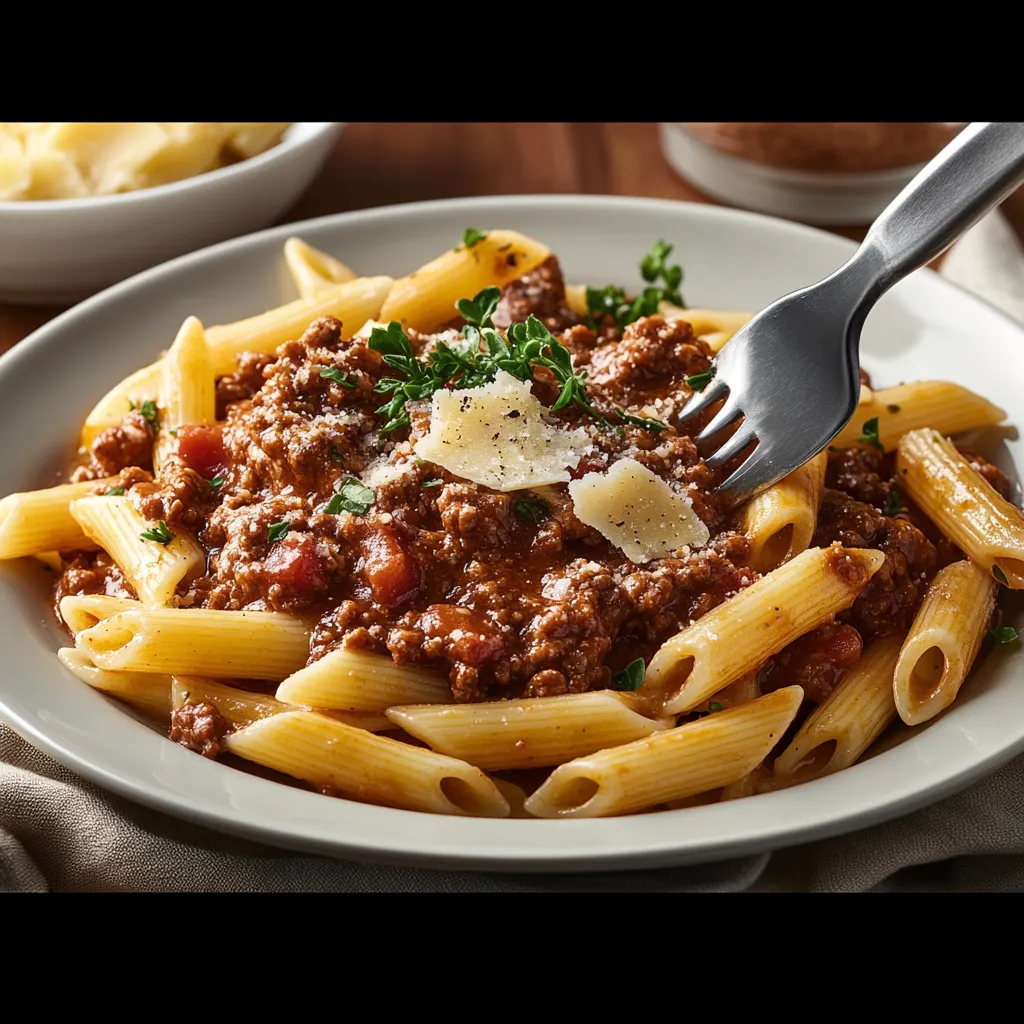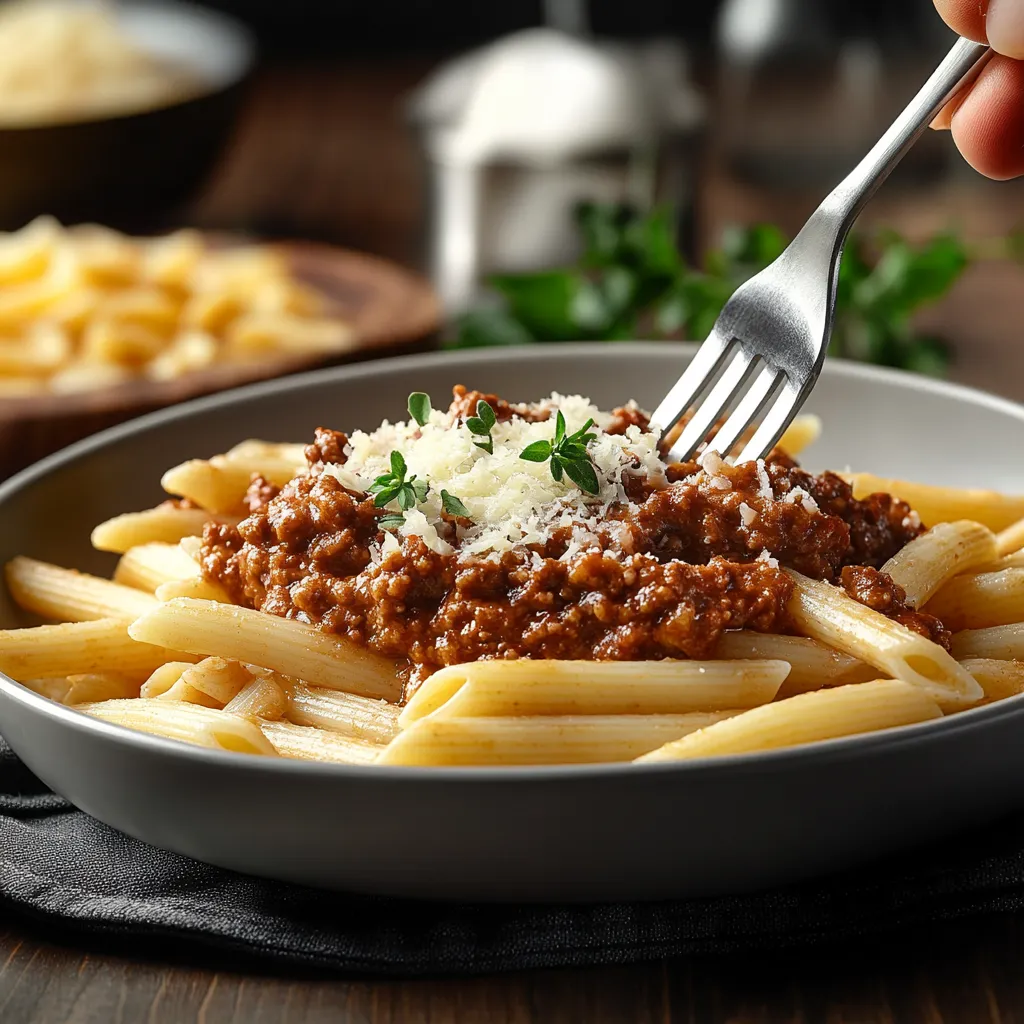 Save
Save
This hearty penne pasta with bolognese sauce transforms simple ingredients into a comforting Italian classic that satisfies even the pickiest eaters. The rich meat sauce clings perfectly to the ridged penne, creating a balanced bite every time.
I first made this recipe during a particularly hectic week when I needed something that would please the whole family. The way my children's faces lit up with that first bite convinced me this would become our go-to pasta night staple.
Ingredients
- Olive oil adds the foundation of flavor to the sauce begin with quality extra virgin
- Onion carrot and celery create the aromatic base known as soffritto in Italian cooking
- Garlic provides essential depth use fresh cloves for the best flavor
- Ground beef offers rich meaty texture choose 80/20 for perfect fat content
- Tomato paste intensifies the tomato flavor and thickens the sauce
- Crushed tomatoes provide body and tanginess look for San Marzano for authenticity
- Milk softens the acidity and adds silky richness whole milk works best
- Dried herbs infuse gentle aromatics throughout the long simmer
- Penne pasta catches sauce in its ridges and hollow center
- Parmesan cheese adds nutty saltiness freshly grated makes a huge difference
Step-by-Step Instructions
- Prepare the Base
- Heat olive oil in a large heavy bottomed pot over medium heat until it shimmers but does not smoke. Add the finely chopped onion carrot and celery stirring occasionally until they soften and become translucent about 5 to 6 minutes. This creates the flavor foundation for your entire sauce.
- Brown the Meat
- Add minced garlic and cook for 30 seconds until fragrant then immediately add ground beef. Break up the meat with a wooden spoon into small pieces and cook until no pink remains about 5 minutes. The meat should develop some caramelization which builds deep flavor.
- Build the Sauce
- Stir in tomato paste and cook for a full minute to remove any raw flavor and intensify the tomato taste. Add crushed tomatoes herbs salt and pepper then stir thoroughly. Pour in milk if using and incorporate completely. Reduce heat to maintain a gentle simmer.
- Develop Flavor
- Allow sauce to simmer uncovered for at least 25 minutes stirring occasionally to prevent sticking. The sauce should thicken slightly and develop a rich aroma. Taste and adjust seasoning as needed.
- Cook the Pasta
- While sauce simmers bring a large pot of water to a rolling boil add a generous amount of salt and cook penne until just al dente usually 1 minute less than package directions suggest. Reserve half a cup of pasta water before draining.
- Combine and Serve
- Add drained pasta directly to the sauce and toss thoroughly to coat each piece. If sauce seems too thick add a splash of reserved pasta water. Cook together for 1 minute to allow pasta to absorb flavors. Serve immediately topped with freshly grated Parmesan and torn basil if desired.
 Save
Save
My grandmother taught me to add a pinch of nutmeg to bolognese which sounds unusual but adds an incredible warmth that most people cant identify but absolutely love. Its her secret weapon that made her sauce famous in our small hometown.
The Perfect Al Dente
The difference between good pasta and great pasta often comes down to texture. Cook your penne until it still has a slight firmness in the center then finish cooking it in the sauce. This allows the pasta to absorb flavors while maintaining structure. When you bite into perfectly cooked penne it should offer slight resistance not mushiness.
Make Ahead and Storage
Bolognese sauce actually improves with time making it ideal for meal prep. Store the sauce separately from pasta in airtight containers in the refrigerator for up to 4 days. For longer storage freeze portions in freezer safe containers for up to 3 months. Thaw overnight in the refrigerator and gently reheat on the stovetop adding a splash of water if needed to loosen.
Variations and Substitutions
This recipe welcomes adaptation. For a lighter version replace half the beef with ground turkey. Vegetarians can use finely chopped mushrooms and lentils for a meat free alternative that maintains hearty texture. Those avoiding dairy can skip the milk entirely or use unsweetened almond milk for richness. Red wine lovers can add a splash before the tomatoes for depth and complexity.
The Cultural Context
Bolognese originates from Bologna Italy where its traditionally served with tagliatelle not spaghetti as often seen in America. The authentic recipe ragù alla bolognese dates back to the 18th century and typically simmers for hours. Our version maintains the essence while adapting to modern time constraints. In Italy this sauce is considered a special occasion dish reflecting the care and attention required to develop its complex flavors.
Recipe FAQs
- → Can I make Bolognese sauce ahead of time?
Absolutely! Bolognese sauce actually improves in flavor when made a day in advance. Store it in an airtight container in the refrigerator for up to 3 days, or freeze it for up to 3 months. Simply reheat gently on the stovetop and toss with freshly cooked pasta when ready to serve.
- → What's the best pasta shape to use with Bolognese?
While penne works wonderfully because its ridges and hollow center capture the sauce, other excellent options include tagliatelle, fettuccine, rigatoni, or even spaghetti. The best shapes are those that can hold the chunky meat sauce, so ribbed or hollow pasta varieties are ideal.
- → Why add milk to Bolognese sauce?
Adding milk is traditional in authentic Bolognese and serves multiple purposes: it adds richness, helps tenderize the meat, reduces acidity from the tomatoes, and creates a silkier texture. The milk fats also bind with the meat proteins for a more cohesive sauce.
- → Can I make a vegetarian version of this dish?
Yes! You can substitute the ground meat with plant-based alternatives like lentils, mushrooms, or commercial meat substitutes. For best results, use a combination of finely chopped mushrooms (especially portobellos) and lentils to create a hearty texture similar to traditional Bolognese.
- → What's the secret to perfect Bolognese sauce?
The secret lies in slow cooking. Allow the sauce to simmer on low heat for at least 30 minutes (traditionally up to several hours) to develop complex flavors. Also, be sure to properly brown the meat before adding liquids, as this creates essential flavor compounds through the Maillard reaction.
- → How can I tell when pasta is perfectly al dente?
Start tasting the pasta about 2 minutes before the package directions indicate it should be done. Perfect al dente pasta should offer slight resistance when bitten but shouldn't have a hard center. Remember that pasta continues cooking slightly when mixed with hot sauce, so it's better to err on the firmer side.
